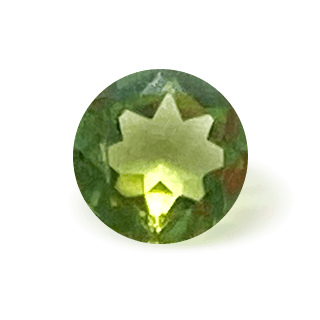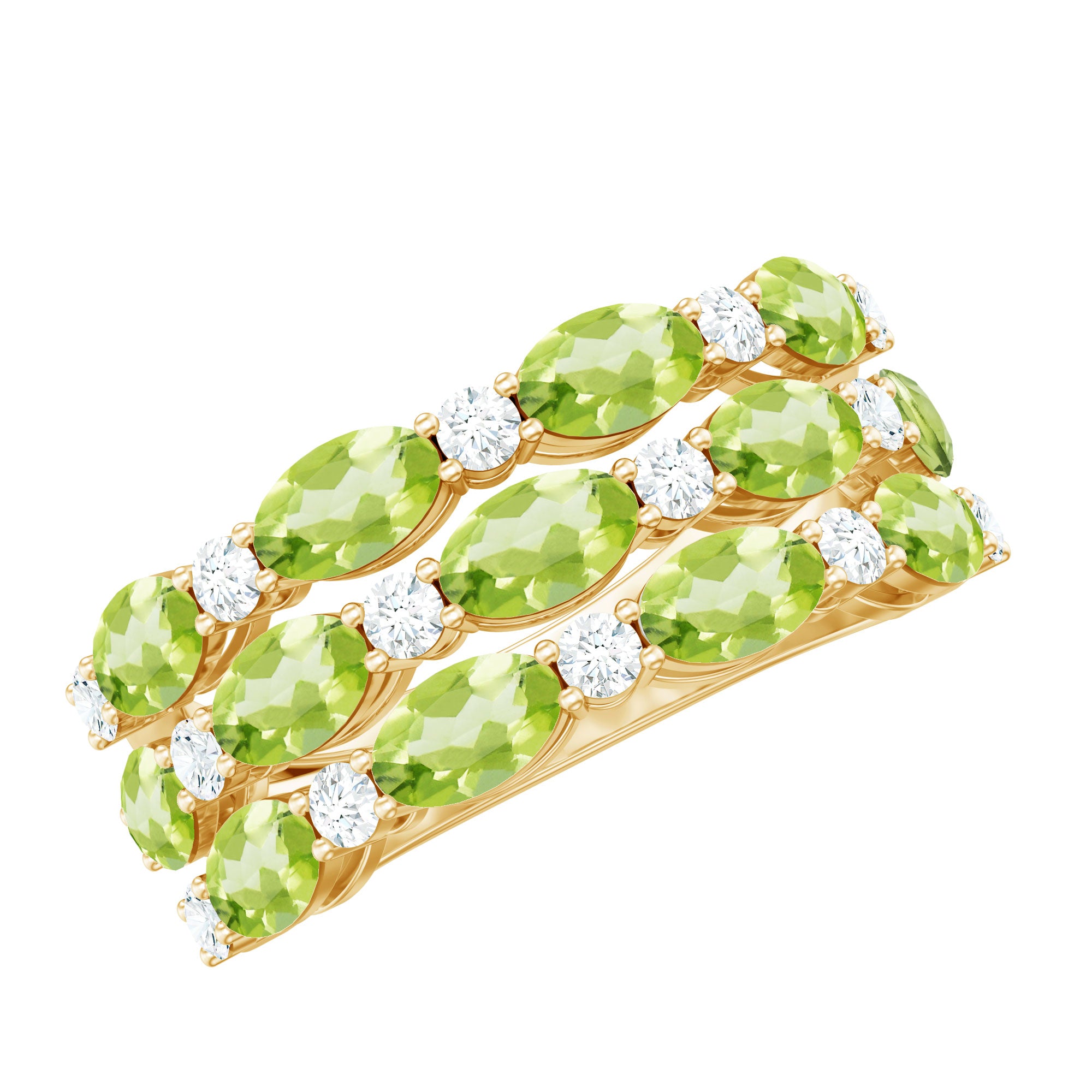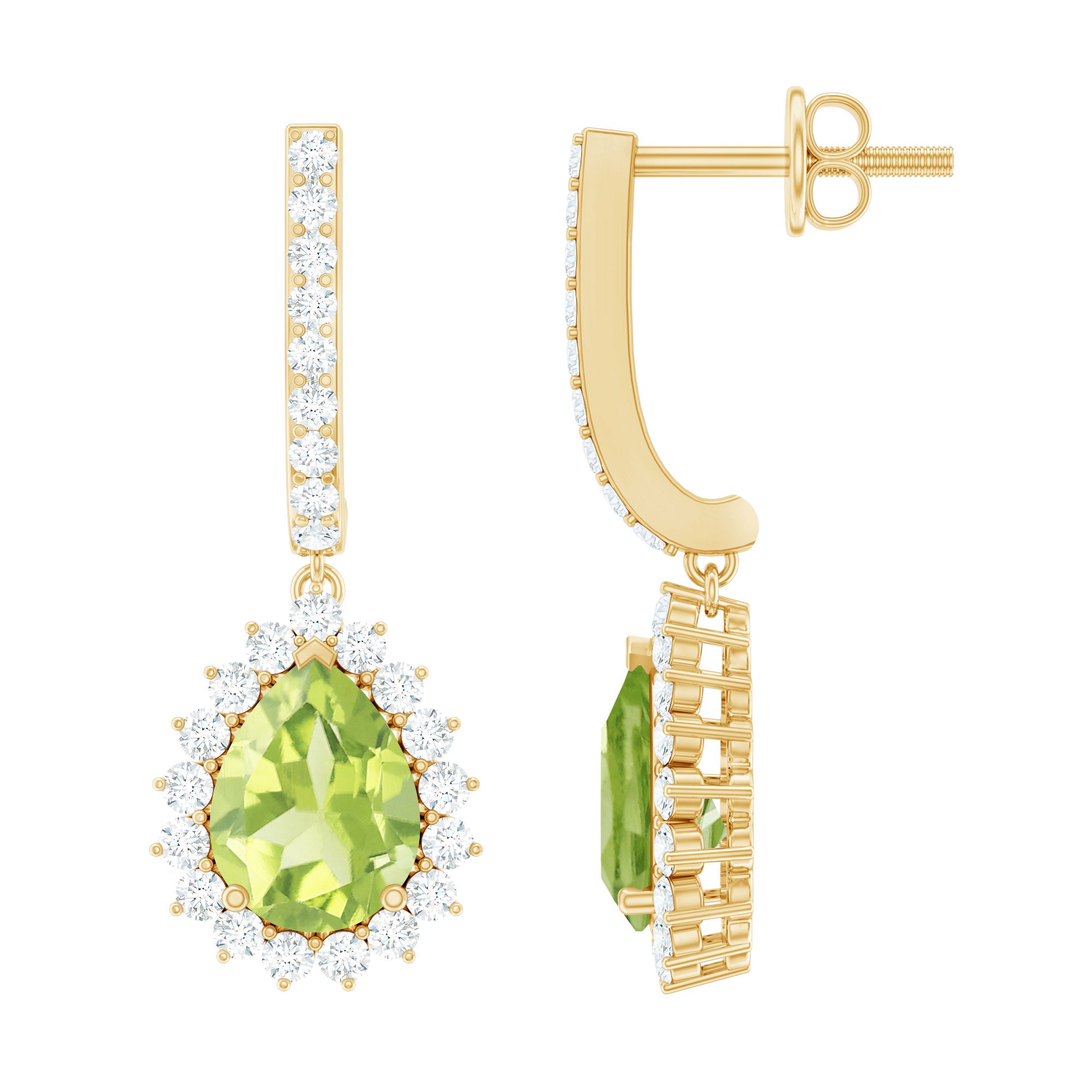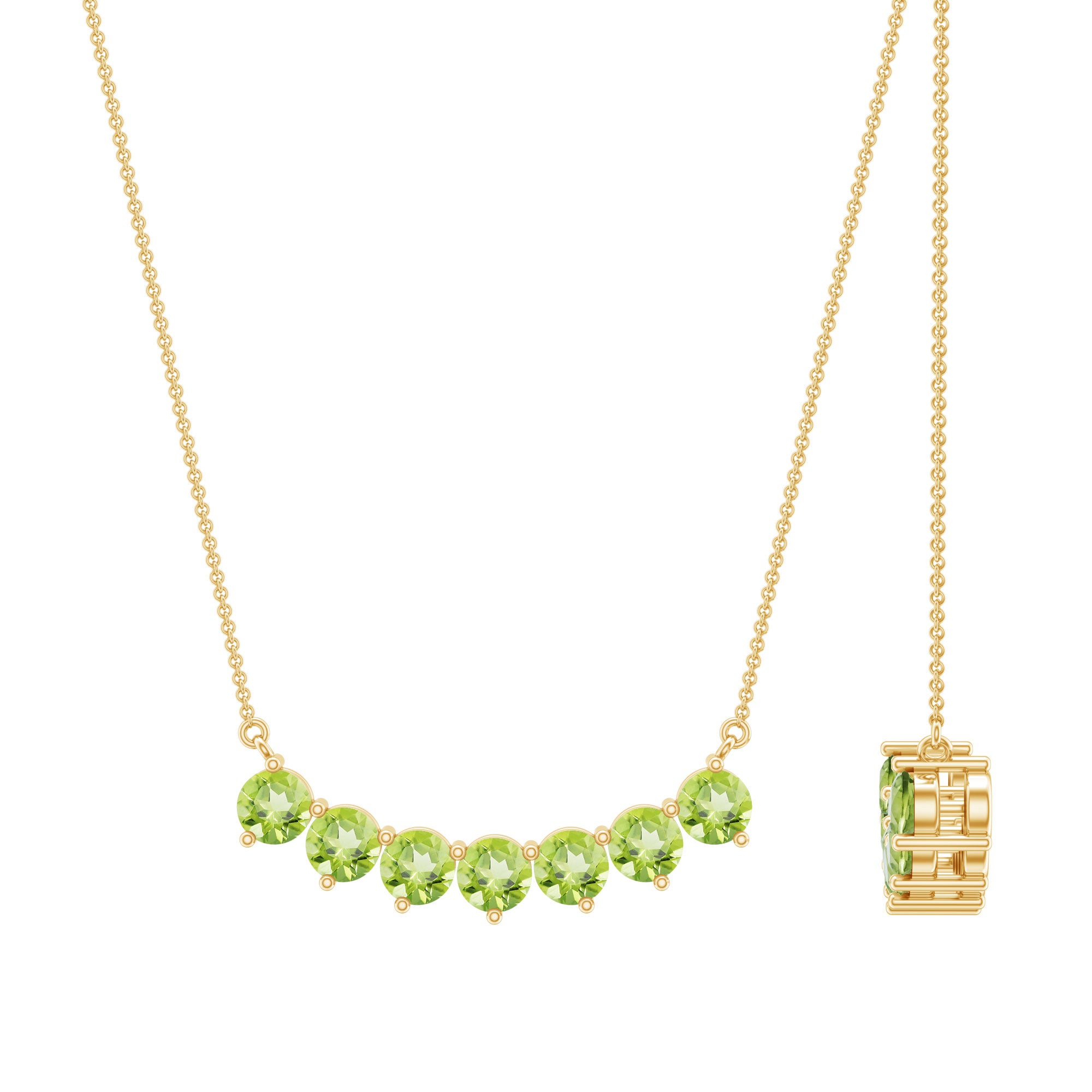All About Peridot: Types, Colors, Description, Origins & Details
Have you seen a color more unique than olive green? No, right? Well, now that justifies the ever increasing craze for Peridot, a semi precious birthstone of August. The most modern color out of the lot probably! Having a tint of yellow with green, Peridot is a feminine French name meaning green gemstone. We’re all so mesmerized by its royal yet modish beauty but isn’t that what makes it curious too? How did it come into picture? What is special about a Peridot? What sets it apart from the other gemstones? Wait no more, our Peridot education guide is here to address all the basic knowledge revolving around peridot, its history and the famous 4 C’s to make a prudent decision while setting out to buy peridot jewelry. Since these are conventionally been used in crafting rings, earrings and all the other jewelry we’re so in love, let’s get you a little more familiar with this august birthstone from the assistance of our Peridot guide:
Properties of Peridot
Hardness
Having a hardness of 6.5-7 on Moh’s scale, it requires a little extra care when worn on a regular basis.
Colors
Being Olive green or green with a tint of yellow, thanks to the presence of iron magnesium silicate, Peridot is known worldwide for its unique color hues.
Luster
Having a refractive index of 1.64 to 1.69, Peridot is known for its vitreous to greasy luster and transparency. More transparent the Peridot, more is its value.
Origin & History
Get ready for the fun part! Here we’ll discuss the interesting and intriguing history of Peridot stone. The history of Peridot dates back to 1500 BC when it was discovered on an Egyptian island interestingly in the red sea by Pliny, a naturalist. He immediately knew he had found a treasure and since then it was known to help get rid of scary nightmares and protect against evil energies. It was so valued that the identity of island was kept a secret till it was re-discovered in the early 1900s. Thanks to its holy elegant color, it was also believed to be the tears of goddess pele falling from the sky. Often confused with Emerald, it was even believed to be largely found in Cleopatra’s collection. See, how engrossing Peridot education just got!
Where is Peridot found?
We’re all lucky to have found this gorgeous beauty that has its special place in our jewelry collection today but wouldn’t be a lot more informative to know where exactly this gemstone if found today! Well, although it is found all over the world, it is largely mined in China, Pakistan, Vietnam, USA, Myanmar and Tanzania. Talking about its specific formation, with the help of volcanic activity, Peridot is usually mined from igneous rocks and formed under the magma from upper mantle. Yes, that complicated a process and thanks to the re-discovery of the European island, the mining of this August Birthstone is more rapidly done.
Peridot versus Emerald

Peridot
Representing rebirth Peridot is embodied with beautiful olive green color hues,i.e., green with a tint of yellow which makes it such a young choice. Apart from that, Peridot is also known for being eye-clean, i.e., free of visible inclusions and are rarely subjected to any kind of artificial treatment. It has a hardness of around 6.5-7 on Moh’scale contrary to that of Emerald.

Emerald
Representing peace and rebirth, Emerald, is known for its green-blue color hues. Emerald is known to be inclusive of some blemishes and flaws and is generally heat treated to get rid of them. It has a hardness of 7.5 to 8 on Moh’s scale.
Peridot Quality and Price Filters
Thanks to its unique olive green color hues, the demand for Peridot is on the rise and the overall quality can be judged from its 4 Cs (cut, color, clarity and carat) that dominate its entire appearance. Let’s give you a sneak peak with our Peridot guide:
Color
Mostly, the colored favored while choosing a Peridot is a rich saturated green to a slight yellowish green free from a brown tint. The smaller gemstones often shows brown undertones which can lower the worth of peridot. As compared to other colored gemstones, peridot has quite narrow color range.
- Yellow Green: Green having a slight or more yellow green tint is known to belong to this category.
- Lime Green: Probably another sought after colors of Peridot having greenish-yellow tint.
- Olive Green: Here we come to the color that Peridot is most known for: an intense olive green color.
- Vivid Green: The color that has no visible tint of yellow or green is the most sought after and valuable, thus making vivid green Peridot another sought after category of Peridot.
- Brown Green: Slightly lower in value, brown green Peridot is not such an alluring pick among the lot.
Clarity
Like most of the gemstones found in the Earth’s crust, Peridots are no different when it is said that clean and clear peridots are rare to find. Clarity can directly determine the price of the Peridot and as long as the inclusions are not detectable by the naked eye. High Quality Peridots will contain no eye-visible inclusions.
Carat
The carat weight of Peridot, having a huge impact on its price, ranges between 0.01 to 2 CT.
Cut
The overall color and brilliance of the Peridot can be determined by the Cut offered by skilled cutting. Therefore, any skilled cutter keeps in mind the overall shape, width, depth and faceting of a Peridot. The skills of the cutter contribute to the beautiful sparkle of the gem as much as the conditions which led to its formatio
Peridot Grading Value
Doesn’t anything when graded become all the more easier to understand? Ever thought the grading system that we’ve been witnessing in our report cards ever since school would become so useful while judging the quality of a Peridot stone. Let’s give you a glance at our peridot grading chart:
AAAA
Peridot belonging to this category is top notch in quality containing very few inclusions or blemishes along with rich olive color.
AAA
Peridot that belongs to this category possesses good olive green color and few inclusions.
AA
The Peridot belonging to this category is known for its brilliance and being more included than other categories.
B
The peridot belonging to this category does contain some eye visible flaws along with brownish green color.
Benefits of Peridot
Peridot, fondly known as the gemstone of ‘life and light,’ has been hailed for its wholesome benefits, that we bet you call tell from the vigorous olive green color itself. From physical to spiritual, Peridot has got you covered with everything you’d be looking for in a gemstone. Let’s give you a glance with our Peridot education guide:
Physical Healing
Physical health is everything, specially in today’s time! And imbibing that is this August birthstone that helps with digestion problems, bladder problems, liver problems and pancreas. Basically anything that you can face major issues in!
Emotional Healing
Since Peridot is such a joyful and eloquent gemstone, why wouldn’t it bless the wearer using its emotional healing powers as well? Having been hailed as the stone of compassion, Peridot can cheer the wearer up in no time. Apart from that, it can also help you combat the toxic feelings of rage, anger and insecurity, blessing you with happiness and gratitude.
Metaphysical Healing
Known to balance the mind and body, Peridot is known to bless the wearer with restful sleep, peace and creative instincts as well. In fact, it is known to be so miraculous that having ties with heart chakra, it can even re-unite broken couples and strengthen their love.
Frequently Asked Questions
How is a Peridot formed?
The olive-colored gems were first found by the Egyptians and believed to have been formed deep in the magma of the earth’s crust. They usually surface in igneous rock and on rare occasions, raw Peridots arrived on earth’s surface hitching a lift from a passing meteorite.
What is difference between lab grown and natural Garnets?
Like most of the gemstones, there is an option to choose between natural and lab-created Peridots. One must not confuse “lab grown” with the “fake”. While synthetic is a replica the lab grown is developed in a controlled lab environment.
Notably, there arise two major difference in both categories on the basis of their origin and the price in the market.
Where do Peridots come from?
Peridots were first mined in Egypt and by today, peridots are mined almost in every part of the world like Canary Islands, China, Brazil, Hawaii, Australia, Norway, Pakistan and South Africa.
How to take care of Peridot Jewelry?
Peridot Jewelry is quite easy to clean due to their hardness and durability. However, a few things must be kept in mind like avoiding contact of the gemstone with make-up, harsh chemicals, abrasives.
While cleaning the jewelry make use of lukewarm water and mild cleaning detergent. Soft toothbrush can be used to clean the underside of the peridot.
Also, the jewelry must be individually kept to avoid contact with other jewelry to avoid unnecessary scratches.
What is a Peridot certification?
The most common Peridot Certifications includes from GIA, IGL and HRD labs. It is usually a document you receive on the behalf of the aforementioned 3rd party labs which describes an peridot in all of its characteristics.
Each and every party’s defining grounds may defer.
Is Peridot a lucky stone?
Specially known to be lucky for all the August babies out there, Peridot is well known for bringing good fortune in the life of the wearer with its joyful and vigorous color.
How strong is Peridot?
Being rated 6.5-7 on Moh’s scale, Peridot are known to be quite a durable gemstone. Perfect to be worn anywhere on a regular basis!
Can Peridot be heated?
Peridot, known to be a natural gemstone, is rarely heat treated and when done, it is known to enhance the beauty of the gemstone by minimizing inclusions.
Conclusion
Being a little extra special for all the August babies out there, Peridot is known for its unique olive green color hues. So much so that you cannot help but fall over its unique beauty again and again! Aren’t you already a fan of the royal beauty of Peridot? Something that’s unique, keeps us glued to know everything under the roof about it, and that’s exactly what our Peridot education guide is here for! From the enthralling history to some integral properties and benefits, we have kept it all under one frame. Precisely, we have tried to educate you with a little of everything about this August Birthstone. We hope you got your answer to how to buy peridot as well!




